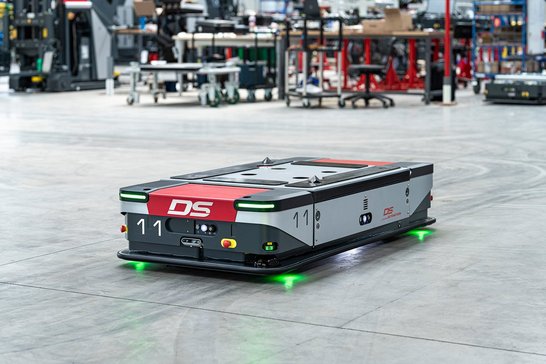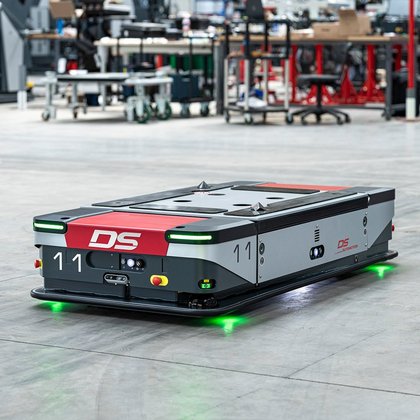The age of driverless transport system has begun. You can see this for yourself at almost every event on the subject of intralogistics - according to the motto: Everything turns, everything moves - and without a driver. Pack & Log asked Wolfgang Hillinger, Managing Director of DS Automotion based in Linz, for an interview to find out more about the background to this remarkable technology.
Share article
Mr. Hillinger, DS Automotion has been involved in the development and production of AGVs since 1984. For a long time, they were rather exotic and served a niche market. Now that has changed fundamentally. What are the drivers behind this development?
Basically, the demand for automation in industry is increasing - worldwide. This development is not new, as it has been going on for decades. However, the shortage of skilled workers has now been added to the mix, and this is acting as a real booster. Because the few workers that are available are used for value-adding activities and not for transporting a product from A to B. This is why people are trying to automate these transports.
In addition, there has been a spin-off within automated transport systems in recent years - to put it bluntly - in the form of so-called autonomous mobile robots, or AMR for short. This has created a second product line in this segment alongside AGVs (Automated Guided Vehicles).
What is the difference between AGV and AMR?
The big difference is that an AGV follows a planned route fully automatically. If an obstacle appears, it stops until it is removed manually. An AMR swerves fully automatically and continues its journey.
Is the AMR therefore the better solution?
It's not quite that simple, because everything has its advantages and disadvantages that have to be weighed against each other. An AGV follows a planned track. If this is free, I always have an orderly flow of material along this route as well as a guaranteed throughput. Overall, a transport system can be operated very economically in this way. We have noticed an interesting additional effect in this context with our customers: In order for AGV systems to work efficiently, more attention is paid to orderliness in operations. This ultimately also leads to transparent production processes.
AMR technology has been developed from within the university environment over the last five to six years. The AMRs act autonomously and choose their route by themselves. They only know their starting and ending point. This is of course very innovative and progressive, and has numerous advantages, but also certain disadvantages. After all, driving from A to B and not knowing the route also means not knowing how long it will take me. In some areas this is completely unimportant, but in many cases it is essential. For example, in production loading, you have to guarantee a certain throughput, and I can't do that with an AMR.
In which areas is the AMR a good fit?
AMR technology is ideally suited, for example, for man-to-goods picking. In practice, this means that a large number of AMRs drive autonomously through the warehouse aisles and stop where picking is required. The pickers then only need to walk down the AMRs and pick according to the instructions on the display. For such an operation, I actually need autonomy, because the vehicles operate in a dynamic environment and have to take evasive action on their own, otherwise the system collapses. Time and throughput are not priorities in this case, and if that is required after all, the system is infinitely scalable. I.e.: If I need a higher picking performance, I simply add additional AMRs.
For me, the question is whether one excludes the other? In other words, can an AGV not drive autonomously, or should it not?
No, they are not mutually exclusive. On the contrary: autonomous navigation is increasingly penetrating the world of AGVs. And we want to combine these two worlds once and for all! That's why we at DS Automotion have developed the so-called "plannable autonomy" and also won the IFOY award in the software category with the ARCOS (Autonomous Robot Control & Operating System) vehicle software based on it. "Plannable autonomy" is a way to navigate vehicles both "virtually lane-guided" and "autonomously". I.e.: Where performance and time are required, it drives as a classic lane-guided AGV.
Now, however, there is also the option of having the vehicle drive like an AMR for return transports, for example, where throughput performance and time do not play a decisive role. For this purpose, we work with zone-based models. The customer can define zones in which the driverless transport system drives either as an AGV or as an AMR.
Furthermore, a hybrid solution also exists. In this case, the vehicle drives on a preferred route, according to the motto: the straight line is the shortest and fastest connection, but if that is not possible, it can also leave the lane, but must return to the lane as quickly as possible.
It sounds like the perfect solution and so simple too ...
It may sound simple, but the house challenge lies in the dynamics of the systems: The vehicle avoids the first obstacle and, due to the new direction of travel, it perceives another obstacle, also avoids this one, then comes another one ... and already it is crisscrossing the area ... possibly it is overtaken in the process by another vehicle that did not have to avoid as much ... and the topic of efficient material flow or just-in-time or just-in-sequence deliveries to the assembly line has already been settled. Therefore, it is always necessary - even with autonomous systems - to pay attention to clear paths, otherwise you are not doing yourself any favors!
In this context, are we actually already talking about systems that are equipped with AI?
For us, the topic of artificial intelligence (AI) begins with the use of camera-based systems. This is because such systems recognize certain plant states or situations and can decide what to do as a result.
Nowadays, it is the software and not the vehicle that is at the heart of the system. What does a user do who has vehicles from a wide variety of manufacturers and thus a wide variety of control systems in his plant?
This is a big and tricky topic. For almost 10 years, there has been an effort to standardize fleet control software. Originally, the desire came from the automotive industry, as they realized early on that in the future - in order to generate an efficient production environment - they would need a variety of AGVs and AMRs. Relatively quickly, they were confronted with the situation that driverless vehicles from a wide variety of manufacturers were on the road in their production halls. The systems did not harmonize with each other, and so they quickly reached the limits of what was possible.
Therefore, the desire for a higher-level fleet control software was great.
That is why - under the umbrella of the VDMA - a standardized interface was created in the form of VDA5050, which makes it possible for vehicles from different manufacturers to operate under a common control system and also to interact with each other. This allows users to operate the control system and the vehicles separately. For example, they can use uniform control systems for all vehicles regardless of their manufacturers, thus limiting the cost of personnel training and software maintenance.
VDA5050 has also already established itself as a standard. This has led to a further increase in the range of driverless transport systems on offer. This is because vehicle manufacturers with no ambition to also offer a control system are now also entering the market.

OSCAR omni
Thanks to its extremely low design, OSCAR omni from DS Automotion is suitable for a large number of underride transports. A high payload of 1000 kg makes it an absolute transport specialist.


